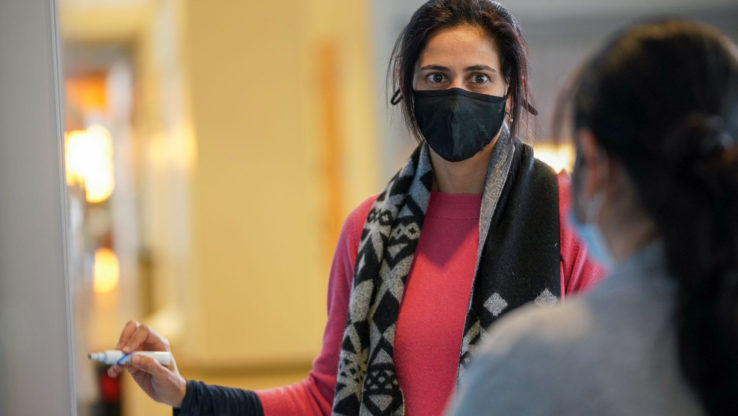Help Us Fight
Coronavirus
You can support our groundbreaking COVID-19
research by making a contribution today.

 subramanian.isbscience.org/2022/01/25/predicting-long-covid-at-initial-point-of-covid-19-diagnosis/
subramanian.isbscience.org/2022/01/25/predicting-long-covid-at-initial-point-of-covid-19-diagnosis/An ISB-led study has identified several factors that can predict if a patient is likely to develop long COVID. In this video, three of the paper’s authors – Dr. Jim Heath, Dr. Yapeng Su and Daniel Chen – discuss some of the implications of their work.
A significant portion of people who contract the SARS-CoV-2 virus – some estimates suggest more than 40 percent – suffer chronic effects known as Post Acute Sequelae of COVID-19 (PASC), commonly referred to as long COVID. PASC symptoms include fatigue, brain fog, the loss of taste and smell, shortness of breath, and more.
Now, researchers have identified several factors that can be measured at the initial point of COVID-19 diagnosis that anticipate if a patient is likely to develop long COVID. These “PASC factors” are the presence of certain autoantibodies, pre-existing Type 2 diabetes, SARS-CoV-2 RNA levels in the blood, and Epstein-Barr virus DNA levels in blood.
“Identifying these PASC factors is a major step forward for not only understanding long COVID and potentially treating it, but also which patients are at highest risk for the development of chronic conditions,” said ISB President, Dr. Jim Heath, co-corresponding author of a just-published research paper in Cell. “These findings are also helping us frame our thinking around other chronic conditions, such as post-acute Lyme syndrome, for example.”
Additionally, researchers found that mild cases of COVID-19, not just severe cases, are associated with long COVID. They also suggest that administering antivirals very early in the disease course may potentially prevent some PASC.
“Long COVID is causing significant morbidity in survivors of COVID-19, yet the pathobiology is poorly understood,” said Dr. Jason Goldman, co-corresponding author of the paper and an infectious disease expert at Swedish. “Our study pairs clinical data and patient-reported outcomes with deep multi-omic analyses to unravel important biological associations that occur in patients with PASC. Certain findings such as the low cortisol state in patients with long COVID have potential to translate rapidly to the clinic. Our results form an important foundation for the development of therapeutics to treat long COVID.”
Researchers collected blood and swab samples from 309 COVID-19 patients at different time points to perform comprehensive phenotyping which was integrated with clinical data and patient-reported symptoms to carry out a deep multi-omic, longitudinal investigation.
A key finding from the study deals with viral load, which can be measured near diagnosis to predict long COVID symptoms.
“We found that early blood viral measurements are strongly associated with certain long COVID symptoms that patients will develop months later,” said Dr. Yapeng Su, a co-first and co-corresponding author of the paper.
In addition, researchers found the Epstein-Barr virus (EBV) – a virus that infects 90 percent of the human population and is normally inactive in the body after infection – is reactivated early on after SARS-CoV-2 infection, which is significantly associated with future long COVID symptoms. “This may be related to immune dysregulation during COVID-19 infection,” Su added.
The team also found that PASC is anticipated by autoantibodies (which associate with autoimmune diseases like lupus) at diagnosis, and that as autoantibodies increase, protective SARS-CoV-2 antibodies decrease. This suggests a relationship between long COVID, autoantibodies and patients at elevated risk of re-infections.
“Many patients with high autoantibodies simultaneously have low (protective) antibodies that neutralize SARS-CoV-2, and that’s going to make them more susceptible to breakthrough infections,” said Daniel Chen, a co-first author of the paper.
The research project was a collaboration between ISB, Providence, Swedish the University of Washington, Fred Hutchinson Cancer Research Center, Stanford, UCLA, UCSF, and others.
You can support our groundbreaking COVID-19
research by making a contribution today.

What are multi-omics? Why does our microbiome matter? What’s the difference between genetics and genomics? What is a digital twin? ISB and Seattle Science Foundation have partnered to create videos answering questions like these and more, showcasing ISB scientists and their work.
It’s Lyme disease season in many areas of the United States, including the Northeast, the Midwest, and some places on the West Coast. In our latest Research Roundtable event, ISB Associate Professor Dr. Naeha Subramanian discussed the latest Lyme disease research conducted in her lab.

Dr. Naeha Subramanian – an expert in immunology, innate immunity, and host-pathogen interactions, and head of ISB’s Subramanian Lab – has been promoted to Associate Professor. “I am honored with this promotion and excited about the incredible research being conducted in my lab. It is a pleasure and privilege to tackle exciting questions everyday,” she said.
This website uses cookies so that we can provide you with the best user experience possible. Cookie information is stored in your browser and performs functions such as recognising you when you return to our website and helping our team to understand which sections of the website you find most interesting and useful.
Strictly Necessary Cookie should be enabled at all times so that we can save your preferences for cookie settings.
If you disable this cookie, we will not be able to save your preferences. This means that every time you visit this website you will need to enable or disable cookies again.